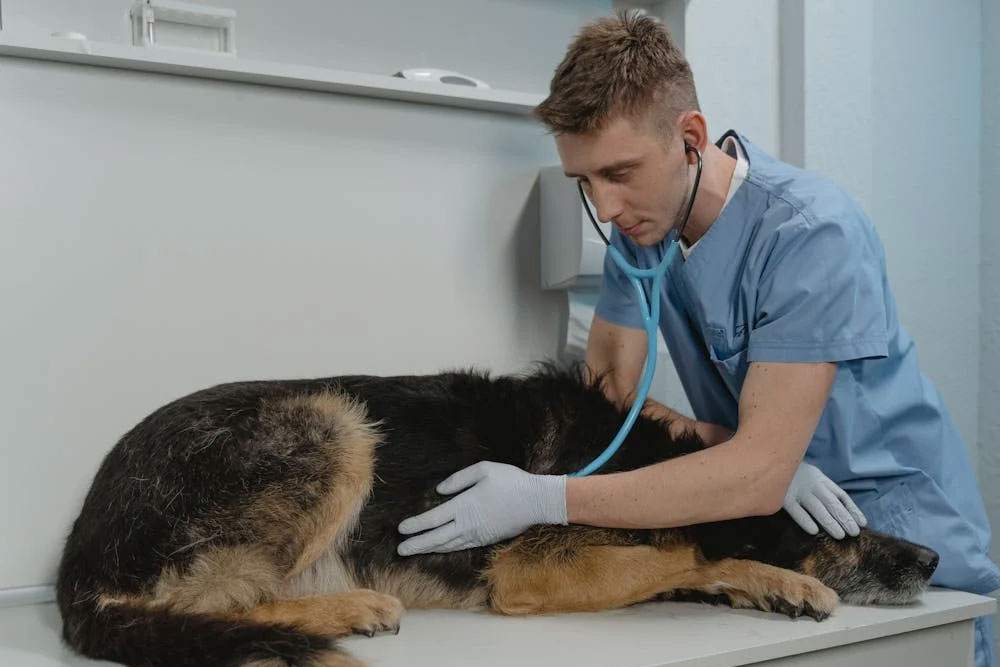Table of Contents Show
Our furry companions hold a special place in our hearts. They’re there to greet us at the door with a wagging tail, cuddle on the couch after a long day, and offer unconditional love.
It’s no surprise then that we shower our pets with affection – and financial resources. According to the American Pet Products Association, pet spending in the US reached a staggering $147 billion in 2023, with a significant chunk ($64.4 billion) going towards keeping our animal friends well-fed. In fact, projections estimate pet food and treat spending to reach $66.9 billion in 2024.
But what happens when the very food you provide to nourish your beloved dog makes them ill? The thought is incredibly unsettling.
Here’s the good news: commercially prepared pet food undergoes rigorous safety measures, so food poisoning from kibble is uncommon. However, it can (and does) happen.
In this article, we explore the signs that might indicate your dog’s food is causing them discomfort and what you should do if you suspect pet food has made your dog ill.
Be sure your dog has food poisoning
How do you know that your dog is suffering from food poisoning and not another unrelated disease? Before you start accusing the food, you want to be sure your dog’s illness is related to their diet.
Ideally, the symptoms should start to show a short period after your dog has eaten. The severity of the symptoms will vary depending on the type of bacteria in the suspected food. They include:
- Vomiting
- Panting and drooling
- Diarrhea
- Uncontrolled peeing
- Hyperactivity
- Cramping
- Dizziness
In severe cases, your furry friend may experience the following symptoms:
- Tremors
- Heart palpitations
- Seizures
- Death
Following the above signs, you can be sure your dog’s sickness stems from its food.
Stop feeding your dog with the suspect food

It’s better to be safe than sorry. If you have your doubts, stop feeding it to your furry friend.
However, it might be difficult to identify the exact type of food causing the illness. Therefore, you might have to withdraw multiple food types as you watch your dog’s symptoms and reactions. If you’ve recently introduced your furry friend to a new diet, then it might be the main culprit.
Continuing to feed your dog the suspect food could exacerbate their symptoms and prolong their illness.
So, withdraw it immediately.
Call your vet

Schedule an appointment with your veterinarian. Before the visit, take note of any symptoms your dog is experiencing, including vomiting, diarrhea, lethargy, loss of appetite, or unusual behavior. It’s also crucial to record how long these symptoms have been present. Remember, the more details you provide your vet, the better equipped they are to diagnose the problem.
During the appointment, your veterinarian will likely ask about any recent dietary changes. Here’s where mentioning your concerns about the current food comes in. They’ll then perform a thorough examination of your dog and potentially run some tests to determine the cause of their illness.
Once a diagnosis is established, your vet will create a personalized treatment plan specifically tailored to your dog’s condition. This might involve medication to address the illness itself, dietary adjustments if the food is indeed the culprit, or other interventions to ensure a speedy recovery.
With prompt veterinary care and a tailored treatment plan, most dogs recover quickly from food-related illnesses.
Your vet will likely schedule follow-up appointments to monitor your dog’s progress and potentially adjust the treatment plan as needed.
Consider the possibility of food allergies
Before you accuse the dog food or the manufacturer for your dog’s illness, consider whether your canine friend has any type of allergies.
Perhaps the food is just fine.
Food allergies are not uncommon in dogs and can cause a variety of symptoms, including digestive issues and skin problems.
Your vet can help diagnose and manage any food allergies.
Get in touch with the manufacturer
Your dog has been treated and is now fairing well.
So what’s next?
Well, in most cases you’ll swear never to buy or feed your companion friend with the suspect food—that’s fine.
But, what if the problem stems from the manufacturer? Would you want other pet owners to go through what you just went through?
Definitely not!
So, once your dog is out of danger, make an effort to contact the manufacturer and let them know that their product caused your dog’s illness.
It is not in the manufacturer’s best interest, financially or otherwise, to keep selling a food or product that causes harm to pets as it could damage their business, reputation and expose them to lawsuits.
Report to the FDA
Additionally, you can report this issue to the U.S. Food and Drug Administration (FDA), who are responsible for ensuring that all types of foods including pet food, is safe, wholesome, and correctly labeled.
You can lodge a complaint from the comfort of your home through the FDA’s Safety Reporting Portal.
Alternatively, you can call your state’s FDA Consumer Complaint Coordinators to report about the suspect pet food causing your dog’s illness.
When submitting a complaint, ensure you have as much information as possible about the food in question. Keep your pet food’s original packaging for essential information about the batch number and its source.
Here’s some crucial information you should have when reporting a pet food to the FDA;
- The exact name of the food and product description (as highlighted on the product label)
- The type of container (bag, box, pouch, can, etc.)
- Lot number—It’s often stamped onto the product packaging. The lot number helps identify the manufacturing plant and the production date.
- UPC (or bar code)
- Product intended to be frozen, refrigerated, or stored at room temperature
- Net weight
- Best by, best before, or expiration date
- Purchase date and exact location where purchases
- How you stored, prepared, and handled the food
Additionally, you should provide information about your dog. This is because the FDA wants to know whether or not it’s the pet food causing your dog’s illness or whether your dog has an underlying condition. Some information you might need to provide include;
- Species (in this case it’s a dog)
- Breed, age, weight, pregnant, spayed/neutered
- Previous health status
- Any pre-existing conditions
- Whether you give your pet any other foods, treats, dietary supplements, or drugs
- The amount of the suspect product your dog normally consumes
- Amount of the “suspect” food your dog consumed from the package
- If you still have the product and in what quantities
- Clinical symptoms your pet exhibited (such as diarrhea, vomiting, and lethargy)
- The time it took for your dog to experience the symptoms after consuming the food
- Your vet’ diagnosis, medical records for your pet and contact information
- Results of any diagnostic lab testing performed on your dog
- If you have more than one dog, state whether any of them didn’t get ill after consuming the suspect food
- Why you suspect the pet food caused the illness
Once the FDA has the information, they’ll review it and determine whether a follow-up investigation is necessary. This may include collecting pet food or treats or enquiring for a diagnostic sample from your pet for analysis.
Final thoughts
When feeding your dog, it’s crucial to adhere to food safety habits like washing your hands before preparing their meal just the way you do with your meals. Unfortunately, many dog owners don’t know or follow the U.S. FDA’s guidelines on safe pet food and dish handling. Sometimes, your pet might be ill because you’re feeding it contaminated food.
Also, if your furry friend experiences adverse symptoms or death from eating the suspect food and you’re absolutely sure it’s the food, you have every right to take legal action. Seek legal advice from an experienced attorney.

